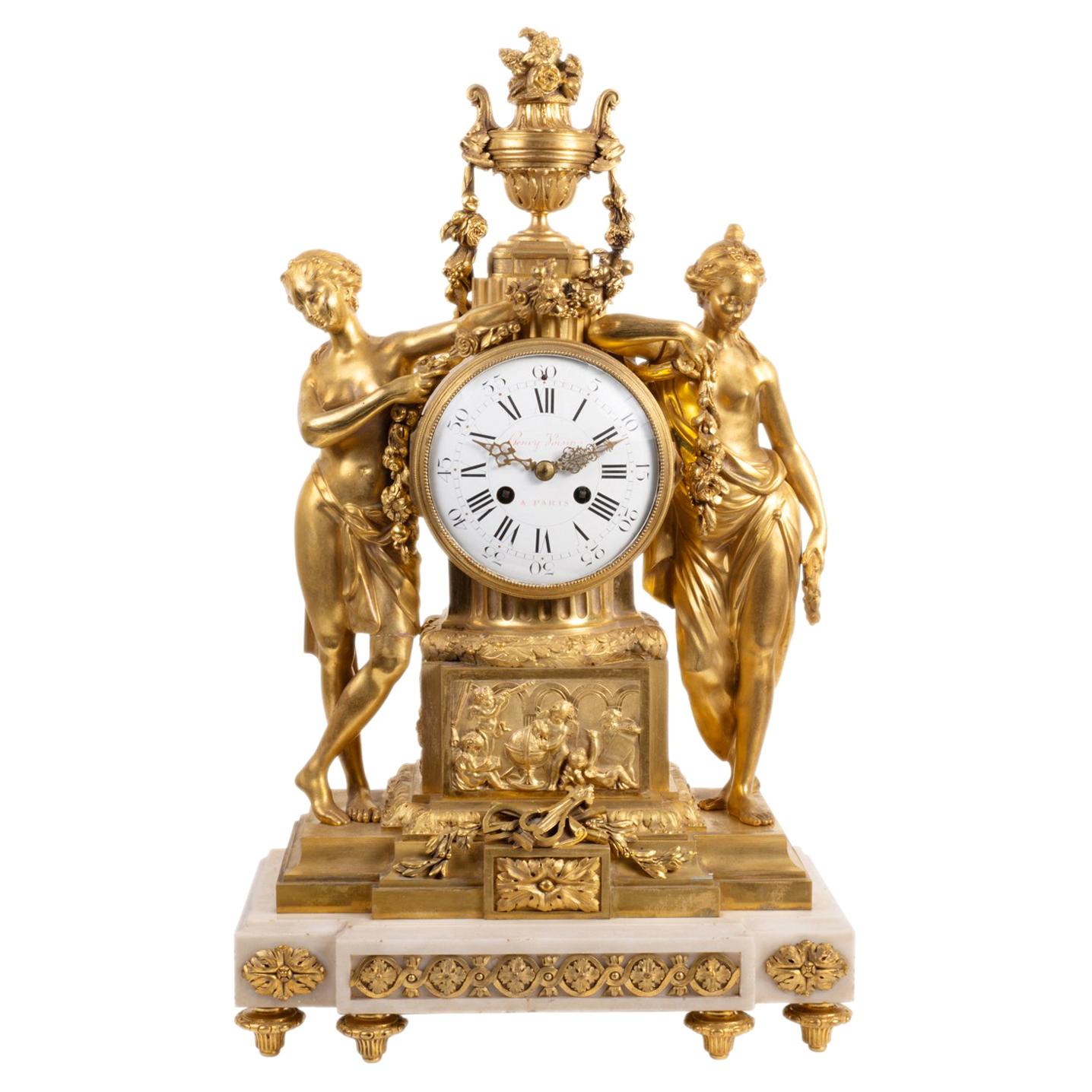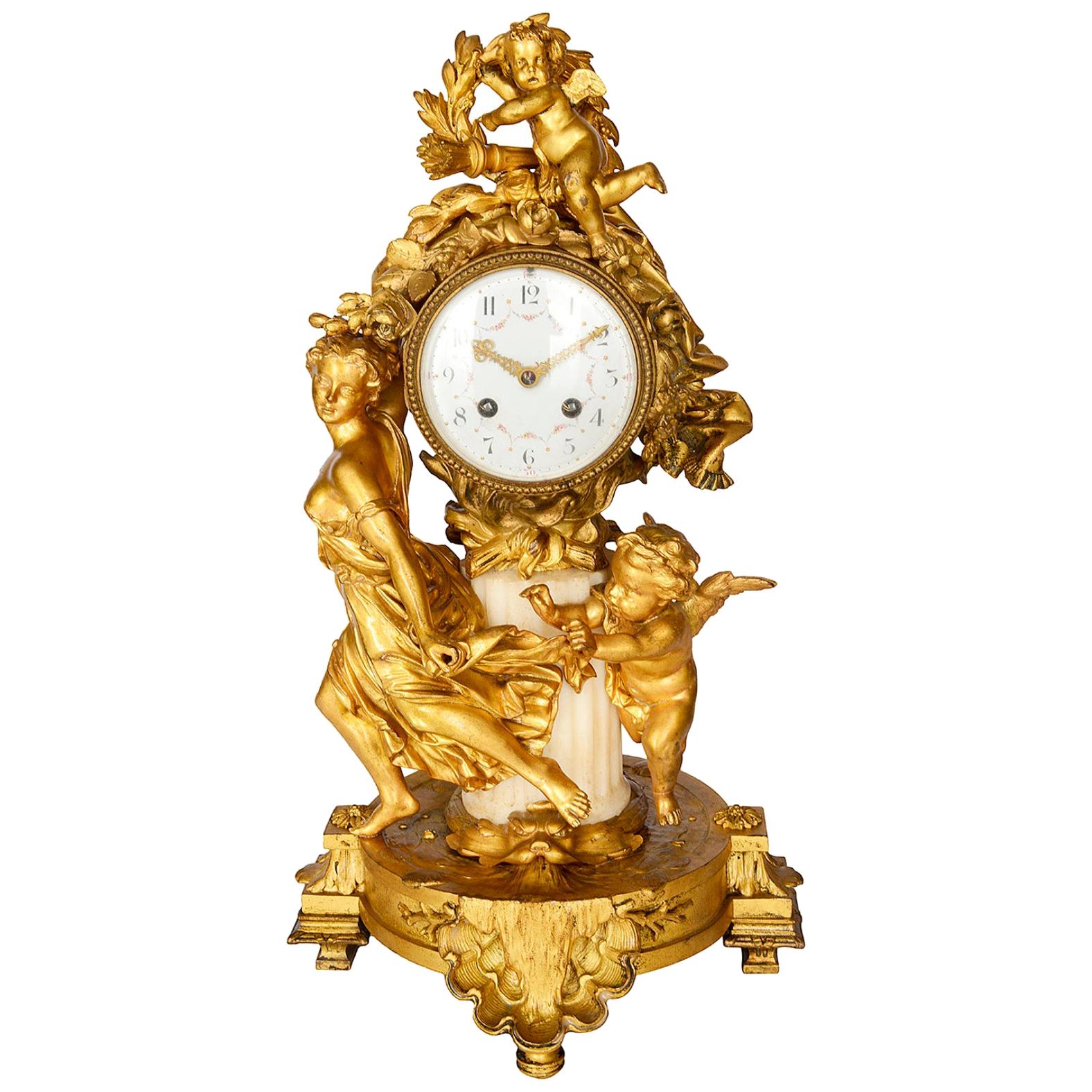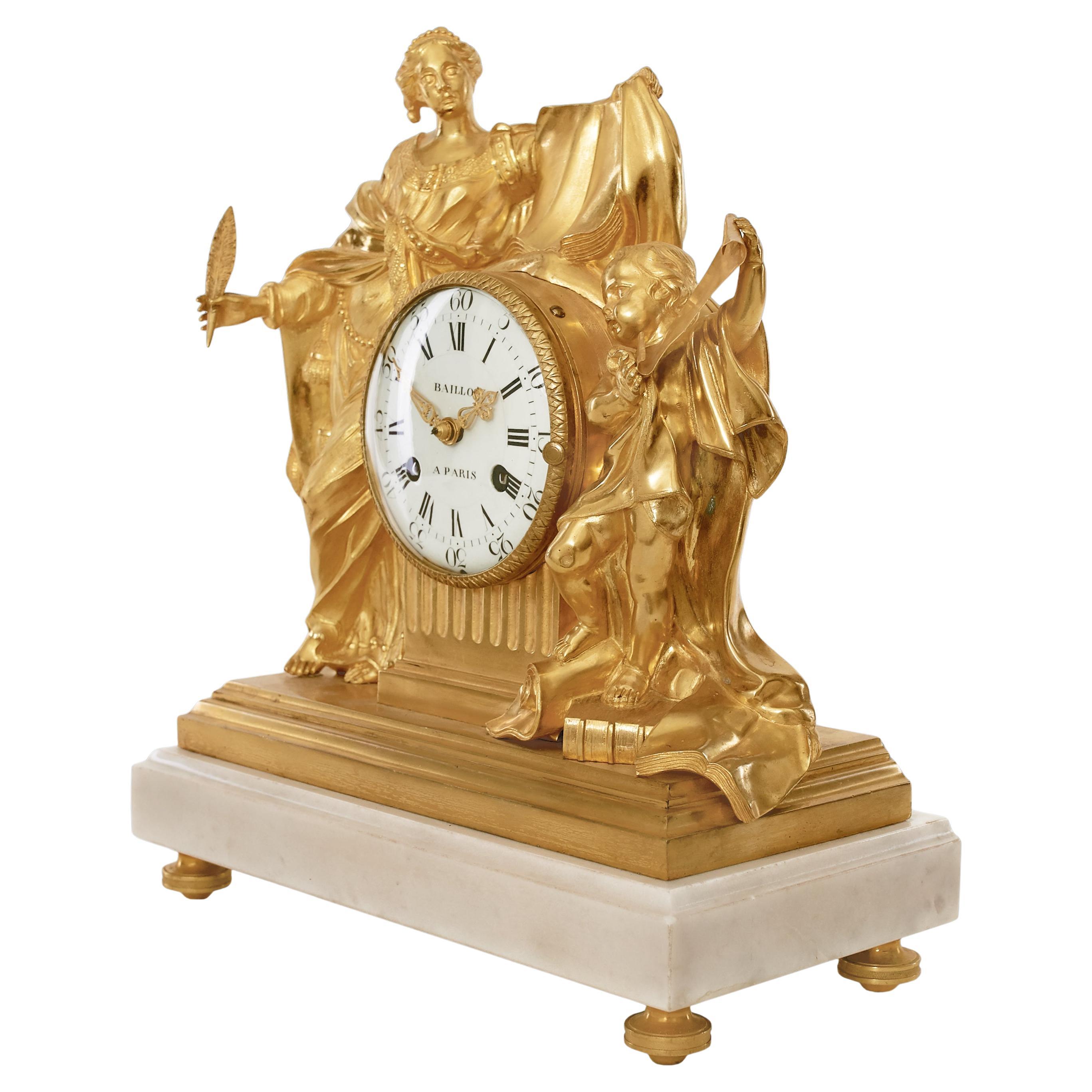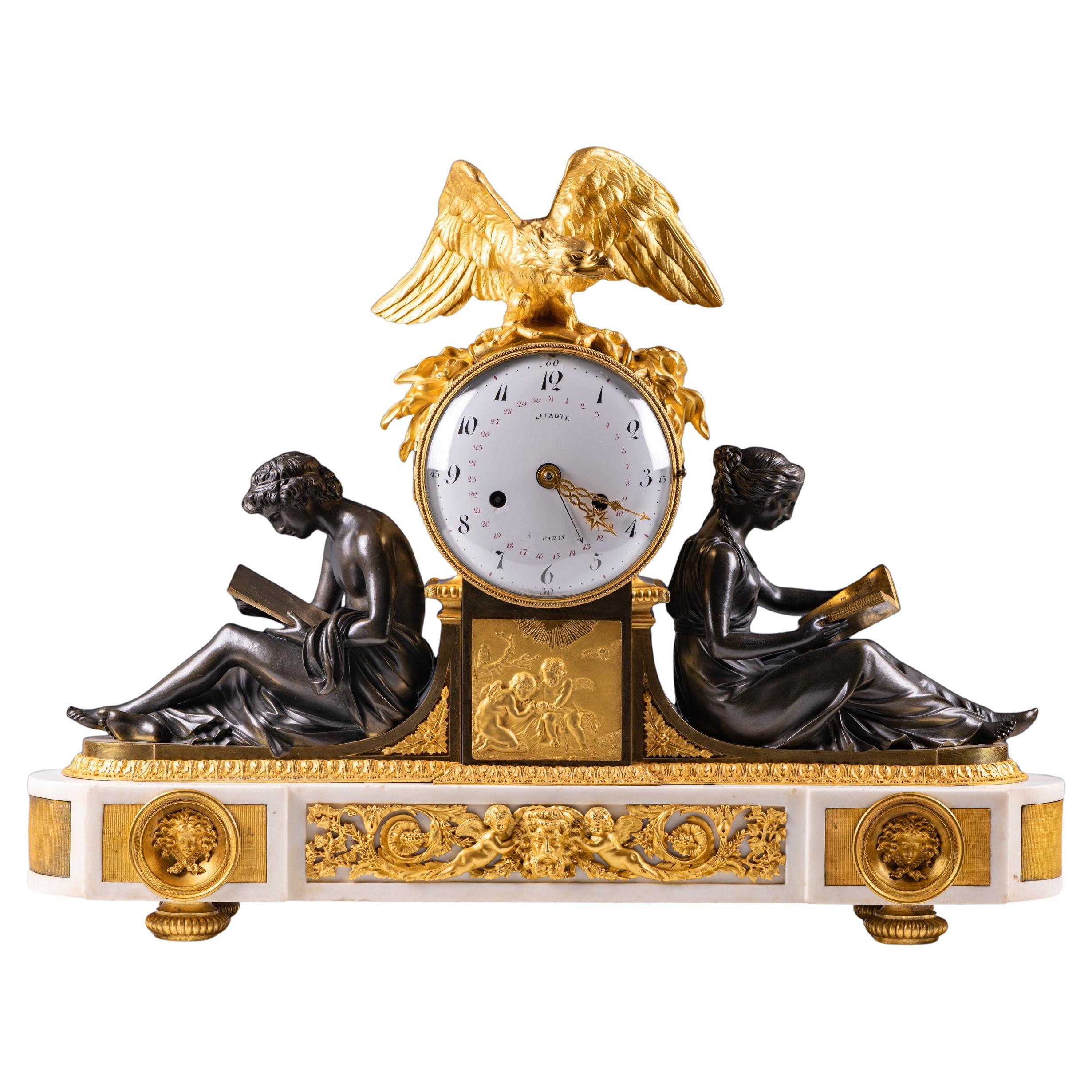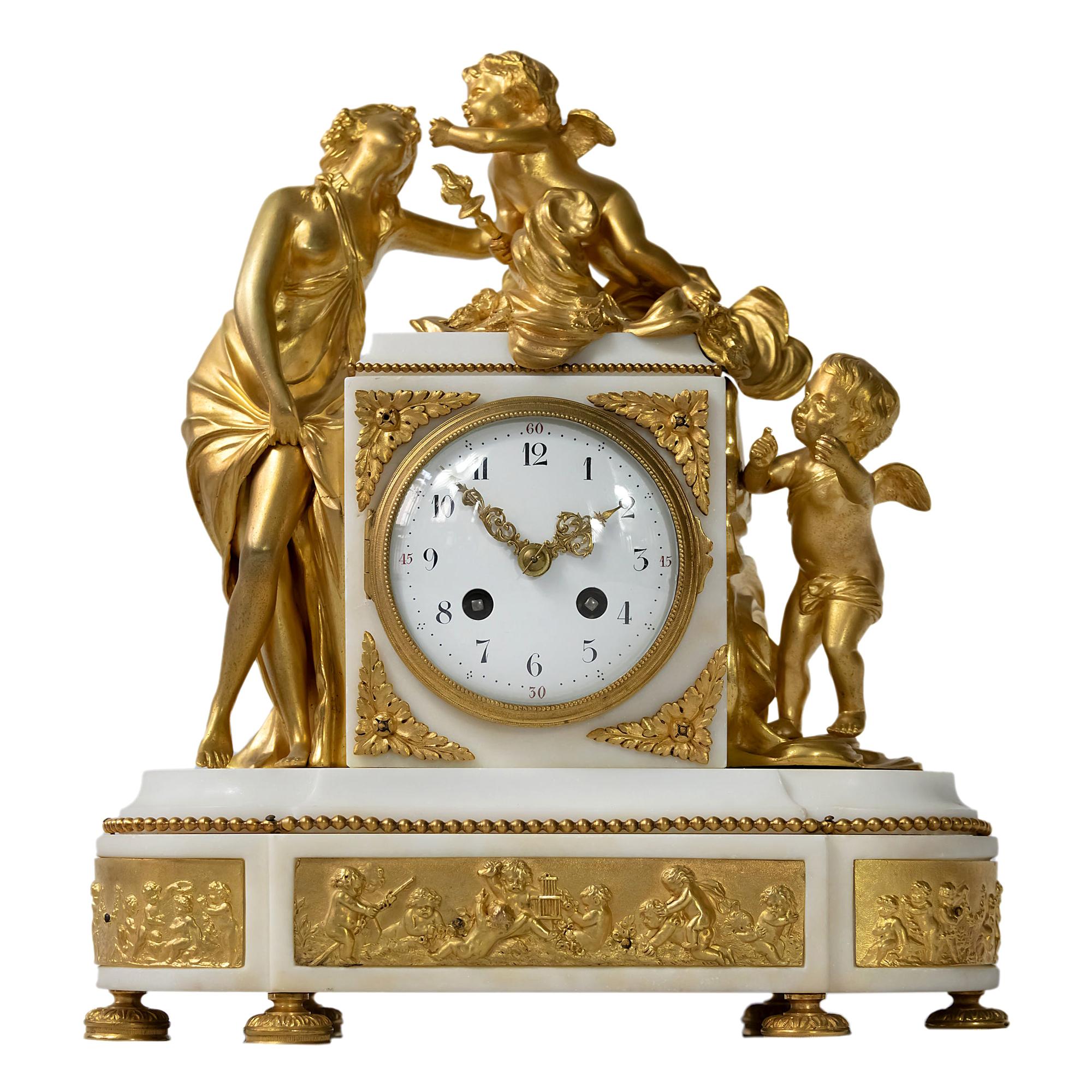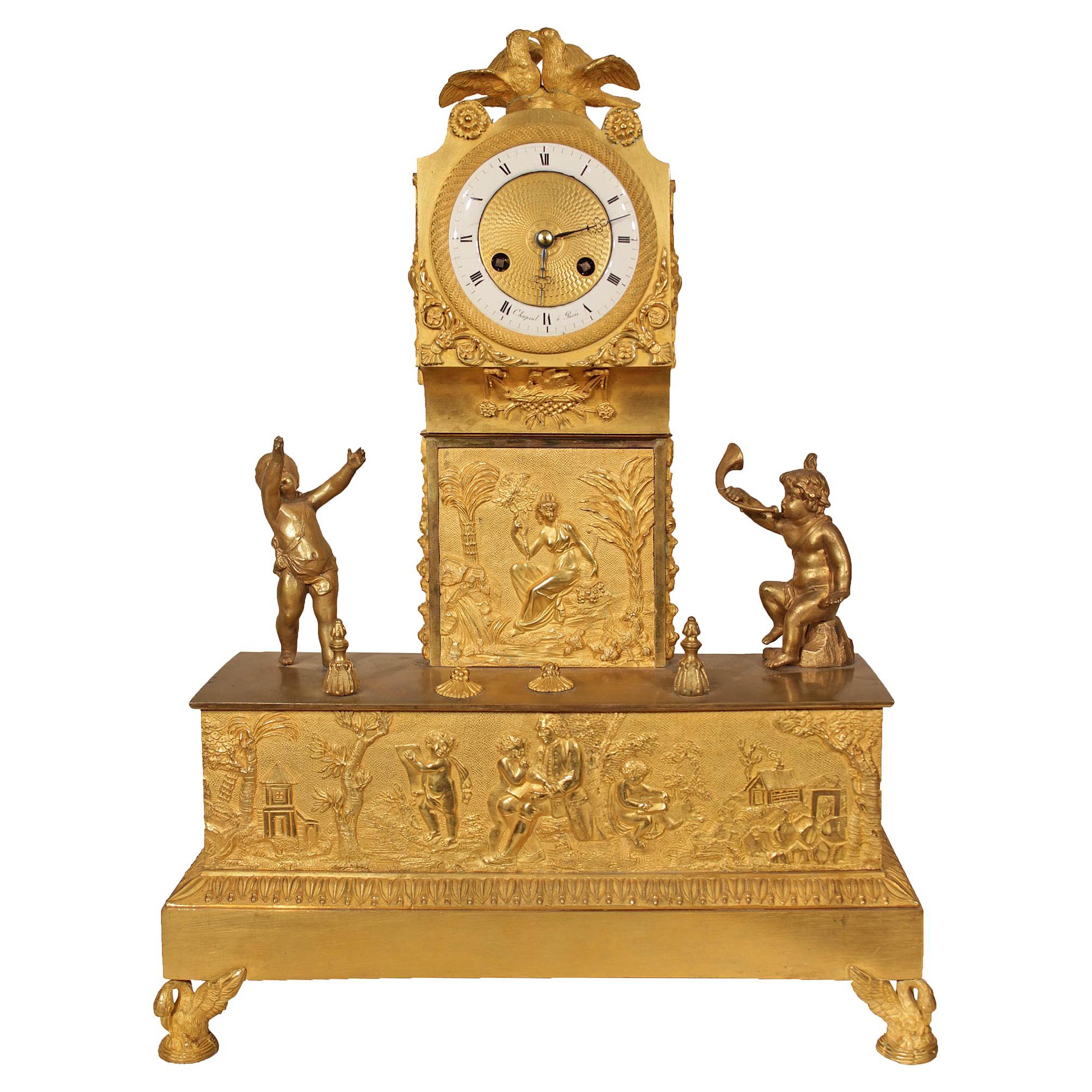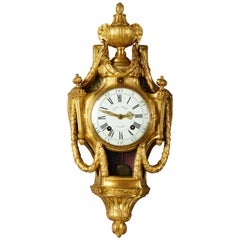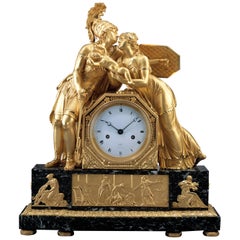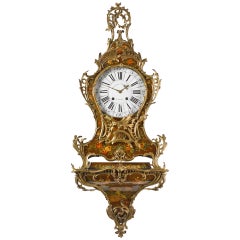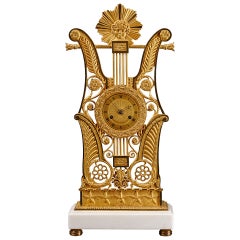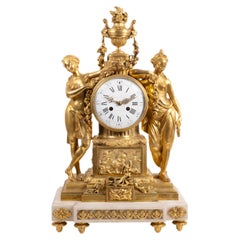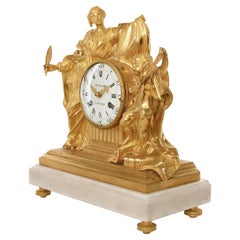Items Similar to Rare Late 18th Century Neoclassical Louis XVI Ormolu Mantel Clock
Want more images or videos?
Request additional images or videos from the seller
1 of 11
Rare Late 18th Century Neoclassical Louis XVI Ormolu Mantel Clock
$81,452.91
£60,908.45
€68,000
CA$112,221.74
A$122,393.58
CHF 64,835.86
MX$1,467,325.22
NOK 825,720.69
SEK 755,060.29
DKK 518,187.10
About the Item
The circular white-enameled dial signed ”Detour Paris” with Roman hours and Arabic quarter marks, a further inner Arabic chapter ring for the day of month. Pierced gilt hands and a blue steel date hand. The three-week movement strikes the hours and half hours. The circular drum case rests on a plinth, the front of which is set with an ormolu panel chased with cherubs playing with doves, it is surmounted by an eagle and flanked by patinated bronze figures personifying Philosophy and Study, (’La Science’ and ’L’Etude’), the shaped rectangular base with rounded ends, mounted with a central pierced ormolu panel chased with scrolling foliage, flowers and cherubs and centred by a bearded mask. With two roundels containing female classical masks. The clock rests on six circular gadrooned feet decorated with acanthus leaves.
This clock, entitled ”L’Étude et la Philosophie” was an enormously successful and popular model in the late 18th Century. It derives from a drawing in a catalogue produced by François Rémond, circa 1785, which incorporates figures designed and supplied to the Sèvres factory for reproduction in biscuit porcelain by the sculptor Simon-Louis Boizot.
Rémond was one of the most celebrated ciseleurs-doreurs during the reign of Louis XVI and counted amongst his distinguished clientele the comte d’Artois and the Princesse Kinsky. Between February 1784 and October 1787, Rémond sold at least thirty-two versions of this model to Dominique Daguerre. In 1788 Daguerre delivered three of these clocks to Louis XVI at the château de Saint-Cloud.
Three virtually identical clocks are in the Royal Collection at Buckingham Palace. A fourth is at Versailles (H. Ottomeyer, P. Pröschel et al., Vergoldete Bronzen, Munich, 1986, vol. I, p. 295, figs. 4.17.5 and 4.17.6.); other clocks of this model are in the Swedish Royal Collection and in the Spanish Royal collection.
- Dimensions:Height: 21.66 in (55 cm)Width: 6.3 in (16 cm)Depth: 27.17 in (69 cm)
- Style:Neoclassical (Of the Period)
- Materials and Techniques:
- Place of Origin:
- Period:
- Date of Manufacture:1785-1790
- Condition:Wear consistent with age and use.
- Seller Location:Worpswede / Bremen, DE
- Reference Number:Seller: 15241stDibs: LU981415149992
About the Seller
5.0
Recognized Seller
These prestigious sellers are industry leaders and represent the highest echelon for item quality and design.
Established in 1979
1stDibs seller since 2013
28 sales on 1stDibs
Typical response time: 1 hour
- ShippingRetrieving quote...Shipping from: Worpswede / Bremen, Germany
- Return Policy
More From This Seller
View AllLate 18th Century, French Louis XVI Neoclassical Ormolu Gilt Bronze Cartel Clock
Located in Worpswede / Bremen, DE
A very fine Louis XVI period ormolu striking cartel clock “aux guirlandes”, the movement signed on the white enamel by Gille L’Aine, Paris. Pierre II. Gille l’ainé (1723-1784) was th...
Category
Antique Late 18th Century French Louis XVI Wall Clocks
Materials
Bronze, Enamel
French Early 19th Century Empire Gilt Bronze Mantel Clock by Claude Galle
By Claude Galle
Located in Worpswede / Bremen, DE
Claude Galle, (1759–1815, master in 1786) is one of the most renowned bronziers active during the Napoleonic period, such as Pierre-Philippe Thomire, André-Antoine Ravrio and Louis-S...
Category
Antique Early 1800s French Empire Mantel Clocks
Materials
Marble, Bronze
Rare French 18th Century Louis XV Vernis Martin Cartel Clock by Festeau le Jeune
Located in Worpswede / Bremen, DE
The clock case decorated overall with very fine ‘Vernis Martin’ lacquer paint with floral sprays and garlands. The waisted case with pierced foliate bronze mounts and surmounted by a foliate finial with a bird. On scroll feet, the bracked conformingly mounted and decorated with a scene with dogs. A fine three week going movement, striking half and full hours on a silvered bronze bell. Festeau Le Jeune became master in 1769. Clock case and bracket are stamped by the ebenist ‘A. Gosselin’ (Antoine Gosselin 1731-1794, Paris, master in 1752), as well as the stamp of the Parisian gilt ‘JME’.
In French interior design, Vernis Martin is a type of lustrous lacquer substitute widely used in the 18th century to decorate a wide variety of items from furniture and coaches to such personal articles as fans and snuffboxes. The technique was named after the French brothers Guillaume and Etienne-Simon Martin, who perfected the process, but covers work by other craftsmen as well. Highly praised by Voltaire, it was developed to imitate East Asian lacquerware...
Category
Antique 18th Century French Louis XV Clocks
Materials
Bronze
French Restauration Period Ormolu Lyre Mantel Clock with Apollo Mask
Located in Worpswede / Bremen, DE
An unusual French Restauration period ormolu mantel clock. The elaborately pierced gilt bronze case in the form of a lyre, with an Apollo mask cresting, on a white marble stepped bas...
Category
Antique 19th Century French Empire Clocks
Materials
Marble, Bronze
18th Century Louis XVI Ormolu and Marble Obelisk Mantel Clock
Located in Worpswede / Bremen, DE
Signed: Joseph Gay Horloger du Roy A Turin
The movement is contained in a white marble obelisk which is surmounted by an armillary sphere finial. The front with a panel chased wit...
Category
Antique Late 18th Century Italian Louis XVI Mantel Clocks
Materials
Marble, Ormolu
Early 19th Century Empire Mantel Clock by Ledure with Apollo or Eros
By Claude Hemon, Pierre-Victor Ledure
Located in Worpswede / Bremen, DE
The clock is signed on the enamel dial by the famous Parisian bronzier ”Ledure Bronzier à Paris” and the clockmaker ”Hedon Hr" (horloger). Patinated and fully sculpted bronze figure ...
Category
Antique Early 19th Century French Empire Mantel Clocks
Materials
Bronze
You May Also Like
Large Louis XVI Style Ormolu Mantel Clock, 19th Century
By Henri Voisin
Located in Brighton, Sussex
A Fine quality French 19th century gilded ormolu and white marble mantel clock in the Louis XVI style. Having a two handled urn to the top with flowers and garlands draping down to t...
Category
Antique Early 19th Century French Louis XVI Mantel Clocks
Materials
Marble, Ormolu
$9,275 Sale Price
20% Off
French 19th Century Louis XVI Style Mantel Clock
Located in Brighton, Sussex
An enchanting late 19th century French gilded ormolu and marble mantel clock, depicting cherubs playing, one chasing a young girl, the other hiding amongst a wreath and foliage. The ...
Category
Antique Late 19th Century French Louis XVI Mantel Clocks
Materials
Marble, Ormolu
Mantel Clock 18th Century Louis XVI Period by Baillon À Paris
Located in Warsaw, PL
This exceptional mantel clock was crafted by Jean-Baptiste Baillon III, one of the most renowned and innovative horologists of his era. Baillon served an elite clientele, including t...
Category
Antique 18th Century French Louis XVI Mantel Clocks
Materials
Marble, Bronze
$5,605 Sale Price
28% Off
Late 18th/19th Century French Empire Mantle Clock By Parisian Clockmaker Lepaute
By Lepaute
Located in Dublin, IE
A Fine & Most Impressive French Gilt, Patinated Bronze and White Marble Mantel Clock by Lepaute of Paris, France. Of impressive scale and refined Neoclassical design, the circular white enamel dial signed Lepaute à Paris within a gilt-bronze bezel surmounted by a finely cast and chased gilt bronze eagle with outspread wings perched on a laurel wreath. The clock flanked by two seated classical figures in dark patinated bronze, each reading from an open book, symbolising Knowledge and Wisdom. The central plinth panel finely cast with cherubs in relief, set upon a rectangular white marble base mounted with ormolu friezes of scrolling foliage and masks, raised on toupie feet.
The Lepaute family were among the most renowned horologists of the late 18th and early 19th centuries, supplying timepieces to the French royal court and many important clients of the Empire period. The fine casting and crisp chasing of this example, combined with its balanced architectural design, exemplify the high quality of Parisian clockmaking of the period.
Circa 1800-1810
France
Condition: Excellent overall condition with minor wear to gilding consistent with age. Movement complete and of fine quality. Fully serviced and in working order.
Key present.
Biography:
Jean André Lepaute...
Category
Antique Early 1800s French Neoclassical Mantel Clocks
Materials
Marble, Bronze, Ormolu
French 19th Century Louis XVI Gilded Bronze and Marble Mantel Clock
Located in Vilnius, LT
Antique 19th century French gilded bronze and white marble mantel clock of the period Louis XVI.
Category
Antique 19th Century French Louis XVI Mantel Clocks
Materials
Marble, Enamel, Bronze
French 19th Century Louis XVI St. Ormolu Mantel Clock
Located in West Palm Beach, FL
A spectacular and unique French early 19th century Louis XVI st. ormolu mantel clock, signed by Chapsal a Paris. The clock is raised on finely chased swan supports below a rectangula...
Category
Antique 19th Century French Louis XVI Mantel Clocks
Materials
Ormolu
More Ways To Browse
Late Neoclassicism France
Neoclassical Louis Xvi
18th Century Decorative French Panels
18th Century French Bronze Clock
Rare Antique Clock
Rare Antique Clocks
Louis Xvi Ormolu Marble Clock
French Ormolu White Marble Mantel Clock
18th Century French Clock
French Neoclassic Bronze Clock
Patinated Bronze Figures
Neoclassical Marble Clock
Sevres Biscuit
Cherub Panel
Rare French Clocks
18th Century Mantel Bronze
Rare Antique Mantel Clocks
18th Century Clock Marble
